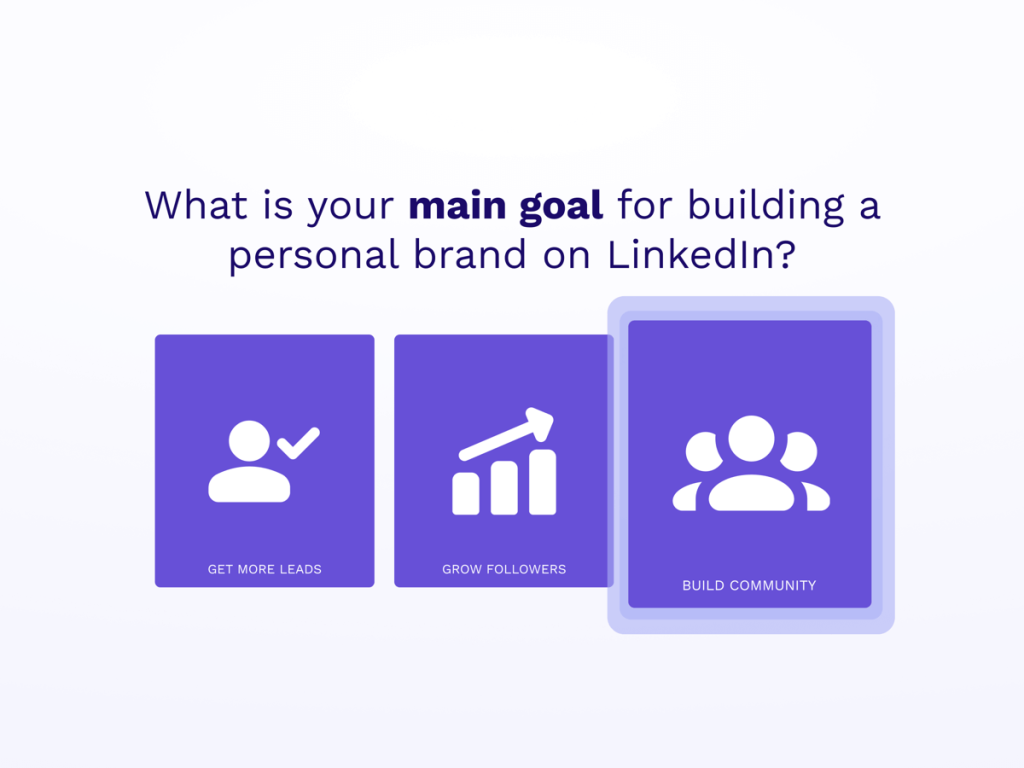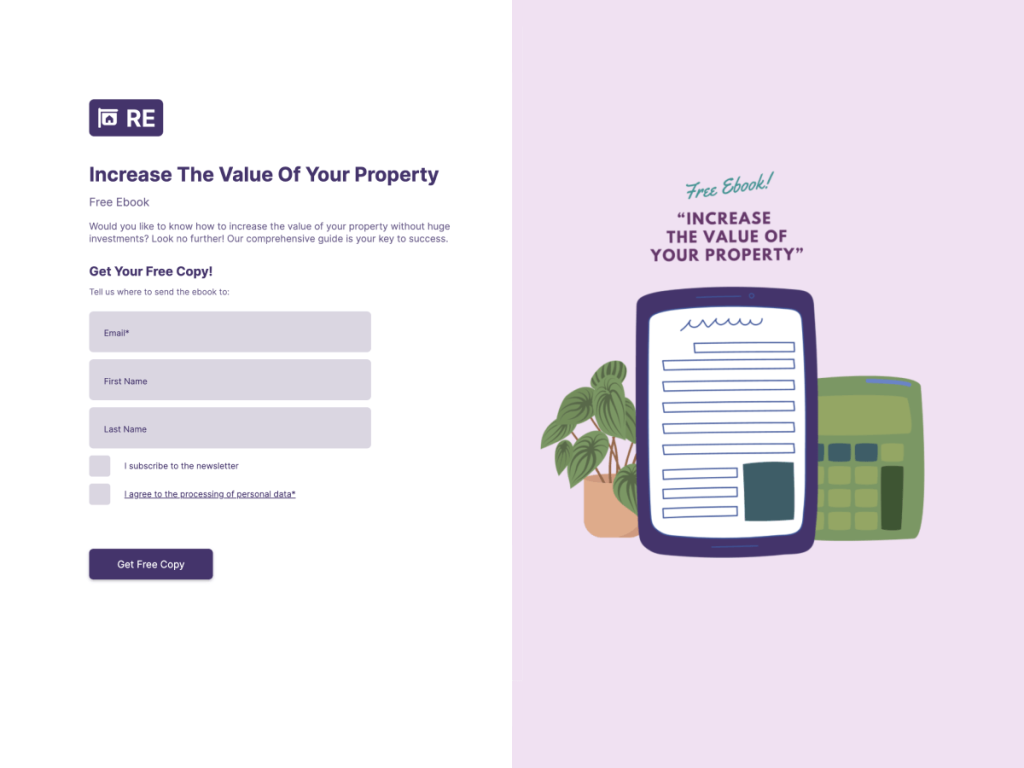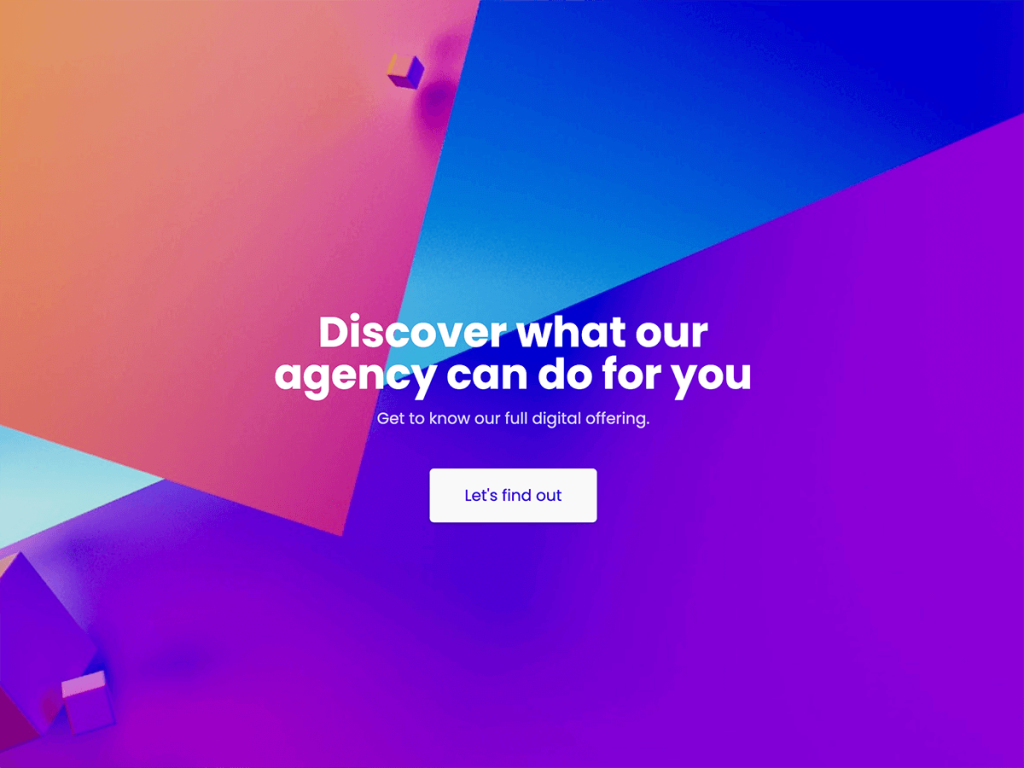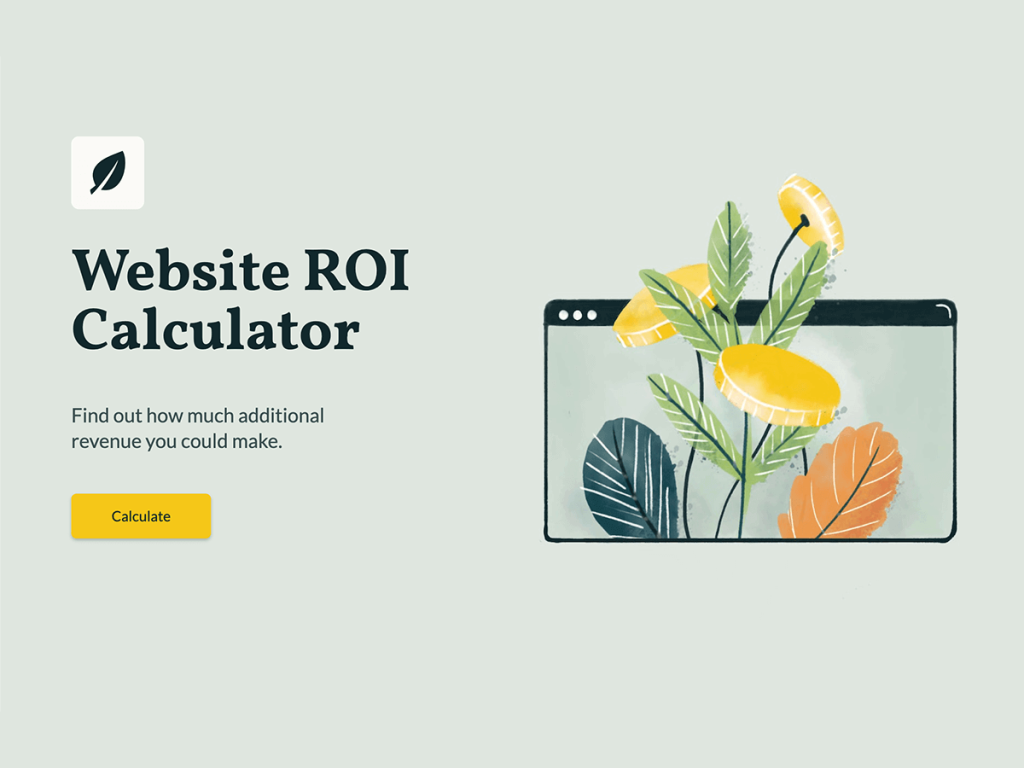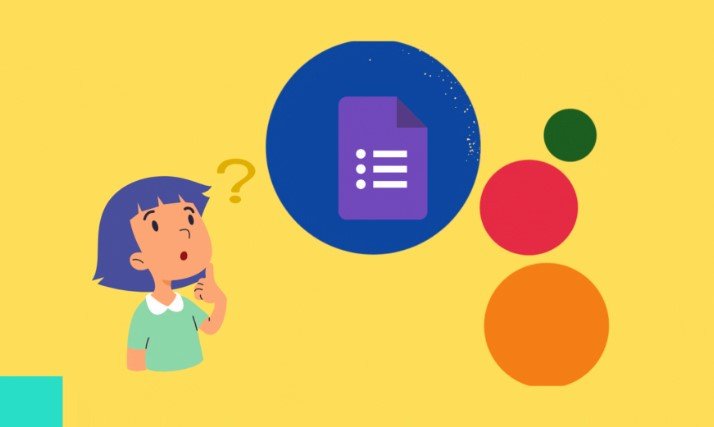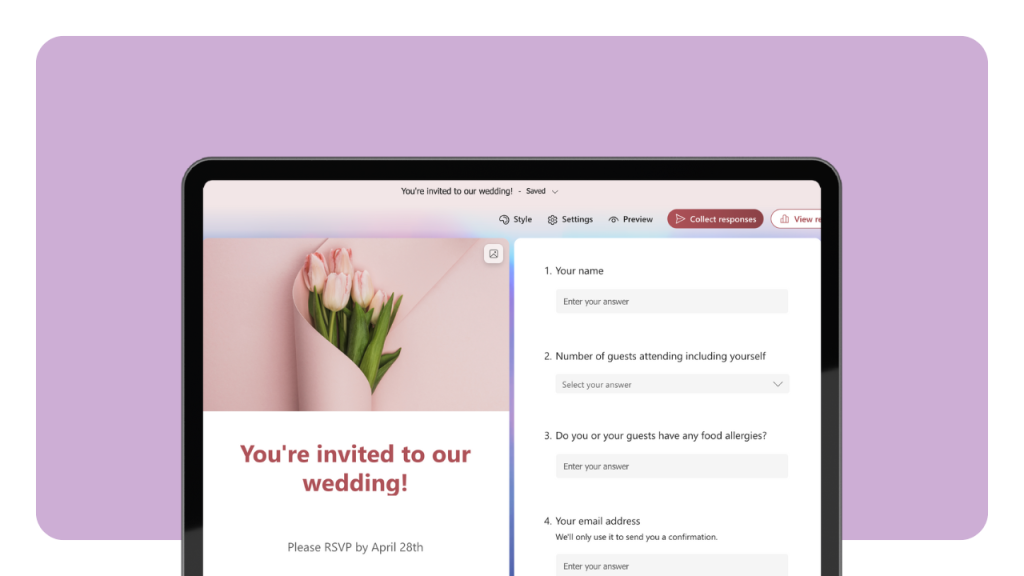Landing page optimization is the art of refining a page so more people do the thing you want: Sign up. Download. Buy...
With user attention spans shrinking and click costs rising, a well-tuned page can be the difference between a bounce and a paying customer.
Here’s the plan:
We’ll cover what LPO is, when to use dedicated landing pages, the anatomy of high-converting pages, a step-by-step optimization process (with landing page optimization examples), helpful tools (including involve.me), common pitfalls, and practical tactics to maximize conversions.
Let’s dive in.
What Is Landing Page Optimization?
Landing page optimization (LPO) is the ongoing process of improving landing page elements (copy, layout, visuals, forms, CTAs) to maximize conversion rate. You optimize for the action that matters to your campaign (sign-ups, downloads, purchases). LPO is not “launch and hope” but test, learn, tweak. Think of LPO as the landing page slice of broader website conversion rate optimization (CRO).
Why Landing Pages Matter in Digital Marketing
Unlike general webpages, landing pages focus on one offer for one target audience. No navigation, no visual clutter, just a straight path to a single action.
And that focus pays off:
Much higher sign-up rates. Optimized landing pages can generate up to 160% more sign-ups than other sign-up elements like pop-ups.
Better focus means better ROI. Sending paid clicks (PPC, email, social) to a tightly matched landing page lowers cost per acquisition.
Bottom line: landing pages exist to convert. They match the visitor’s intent, remove distractions, and make every click count.
LPO Vs. General Web Page Optimization
It’s important to distinguish optimizing a landing page from optimizing a regular webpage (like your homepage or a product page). Different jobs, different playbooks. The key difference is focus.
Landing Page Optimization
One business goal (e.g. capturing a lead or making a sale)
Isolated from site nav
Optimized for conversions on that single goal.
Metrics: CTR to CTA, on-page conversion rate.
Website Page Optimization
Multiple goals (educate, navigate, rank)
Optimized for exploration and SEO (Search Engine Optimization).
Metrics: bounce, pages per session, time on site.
Neither is “better”, they serve different purposes. A homepage is the first page of the website, it provides lots of info and paths, which is great for brand awareness, but a good landing page converts better than traditional web pages by eliminating choices and guiding the visitor to one action.

Benefits: Higher Conversions, Happier Users
Optimizing landing pages is a win-win, really: better experience for visitors, better numbers for you.
Higher Conversion Rates
A tight message match between ad and headline can considerably lift conversions. Refine headlines, visuals, and CTA copy to mirror the promise that brought the click. A generic page would dilute that focus. An optimized landing page ensures you’re squeezing the most value out of your traffic.
Lower CAC
Better conversion means fewer paid clicks per customer. Fix the “leaky bucket” in your funnel, so that more of those paid clicks turn into leads or sales, and acquisition costs drop.
Improved UX
Fast, mobile-friendly landing pages with clear copy and trust signals keep people engaged. Remember: about 53% of mobile visitors leave if a page takes over 3 seconds to load. Speed and clarity protect your funnel.
When Should You Use a Landing Page?
Not every situation needs a standalone page. These do:
Paid Advertising Campaigns (Google, Meta, Etc.)
If you’re running PPC ads on Google, Facebook/Instagram, or other ad networks, you should almost always direct clicks to a specific landing page rather than a generic homepage or product page.
Why? Message match (as I just explained above). You can tailor the landing page to mirror the ad’s message and offer, with a single focused CTA. This is the best way to keep your target audience engaged.
For example, if an ad says “50% off winter boots, limited time,” then the landing page should say the same thing and make buying easy.
Strong ad-to-page message match improves results and often your Google Quality Score (which means lower cost per click).
Email Marketing and Lead Capture Campaigns
When you send an email (whether newsletter, promotional blast, or drip sequence) with a specific offer or call-to-action, linking to a dedicated landing page maintains the momentum. That landing page continues the story from the email, provides more details and captures the conversion.
For example, a marketing email might tease a free eBook download; the “Download Now” button in the email should go to a landing page that gives a bit more valuable information on what’s in the eBook and a form to get it
Don’t drop subscribers on your homepage and make them hunt. They will lose interest.
Seasonal Promos and Launches
When you have a time-bound promotion or a new product launch, a landing page helps you create a dedicated space for that campaign.
Black Friday, holiday bundles, new product drops... A focused landing page lets you highlight urgency, run countdowns, and measure performance in one place.
Similarly, for launching a new product or service, a landing page is great for concentrating attention and measuring interest.
Let’s say you run Google ads announcing the new product. The landing page can educate visitors on its benefits and have a single CTA like “Pre-order now” or “Join the waitlist.
In fact, many startups even validate ideas with a simple “waitlist” landing page before building a full website. This way, they can gauge demand via sign-ups or pre-orders.
Testing Product-market Fit or New Positioning
Landing pages aren’t just for external campaigns, they are also useful for experimentation. If you want to test a new value proposition, marketing angle, or even an entirely new product idea, creating a standalone landing page is a low-risk, high-learning tactic.
Spin up variants for different segments, drive small traffic, and see who bites. Are they signing up? Buying? Which headline or layout yields better conversion? Because landing pages are quick to build and modify, you can iterate rapidly.
For example, you have a product that could appeal to two different potential customer segments, but each cares about a different benefit. You could make two simple landing page variants, each with messaging tailored to one segment, and split your traffic. The results will tell you which angle resonates more. All of this without messing with your main website.
This is essentially an A/B test for positioning.
Try this: If you’re experimenting with a new campaign, involve.me’s platform can speed up the process. Use one of our 300+ pre-built templates to spin up a landing page in minutes (no developer needed), so you can test your idea fast. Perfect for a quick pilot campaign.
Whitepaper Download Template
Appointment Funnel Template
Lead Magnet Quiz for Real Estate Template
Agency Lead Generation Form Template
Customer Profiling Survey for Ecommerce Template
Website ROI Calculator Template
What Makes a High-Converting Landing Page?
Not all landing pages are created equal. Some pages are consistently converting visitors 2-3x better than other landing pages.
So, what’s their secret?
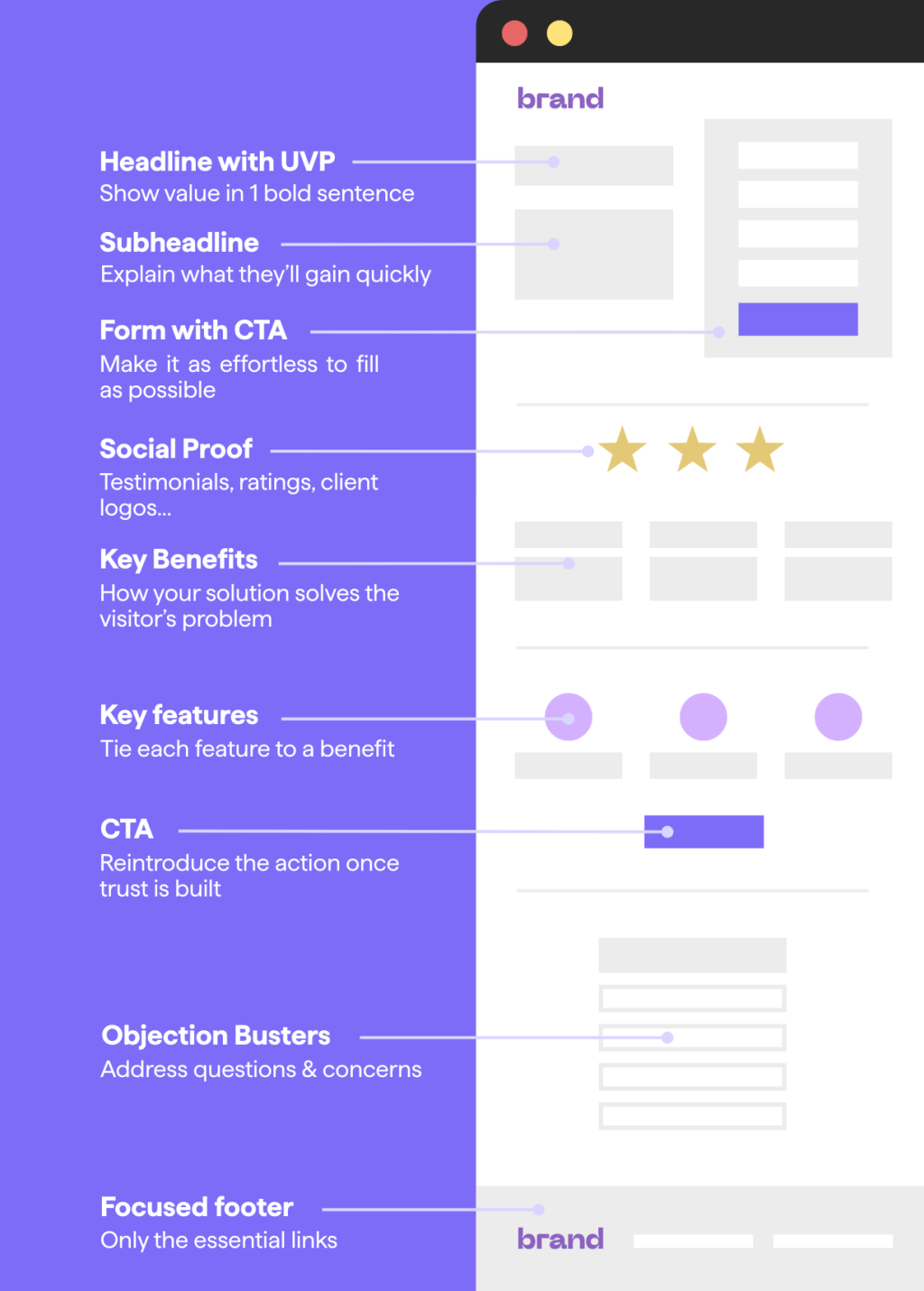
1) A Clear, Customer-centric Value Proposition
Lead with the benefit. “Save 5 hours a week on bookkeeping” beats “Powerful bookkeeping software.” Put the promise above the fold. Landing pages that clearly state value up top can see massive conversion lifts. Make sure it’s concise, compelling, and crystal-clear about the benefit.
2) Focused CTA and Form Placement (above the Fold)
Pick one primary action. Make it prominent, place it near the top and repeat it at logical points. Match the button text to the promised value (for example, “Get the free guide,” not “Submit”). Keep forms short and easy to fill out. Fewer fields, more completions.
3) Mobile Responsiveness and Fast Loading
Often, most of your traffic will come from mobile devices, so create your landing page with a mobile-first angle. Buttons must be tappable, text readable, forms painless. Keep it fast. Each extra second can hurt conversions, as most landing page visitors with abandon a page that takes over 3 seconds to load. Compress images, trim scripts, and keep the page lean.
4) Strong Visual Hierarchy and Contrast in Design
Your landing page design and layout should guide the visitor’s eye to the key elements. This means: big, bold headline. Scannable subheads. Benefits in short bullets. Plenty of white space. High-contrast CTA (call to action). Remove anything that doesn’t move the target audience toward the goal. Use color or directional cues (like arrows or images of people looking toward your form) to subtly nudge attention to the call to action.
5) Personalization and Segmentation
Consumers respond better to messages that feel tailored to them. This implies dynamically changing certain content based on the visitor’s characteristics or behavior. Even small touches help. For example, displaying “Welcome back” for returning customers or “The PM tool for marketing teams” for marketers.
Segmentation can also be achieved through interactive landing page elements on the page. For instance, involve.me’s platform allows you to create funnels with conditional logic, meaning the page can ask the user a question or two and then route them or show them content based on their answers. This way, each visitor gets a slightly customized path that resonates more with their needs.
involve.me highlight: With involve.me, you can easily implement dynamic content or conditional logic to personalize your landing page. For example, you could use URL parameters or quiz answers to dynamically insert a user’s name or show different copy. If a user came from a Facebook ad or a Google ad, involve.me could display a tailored message for each source.
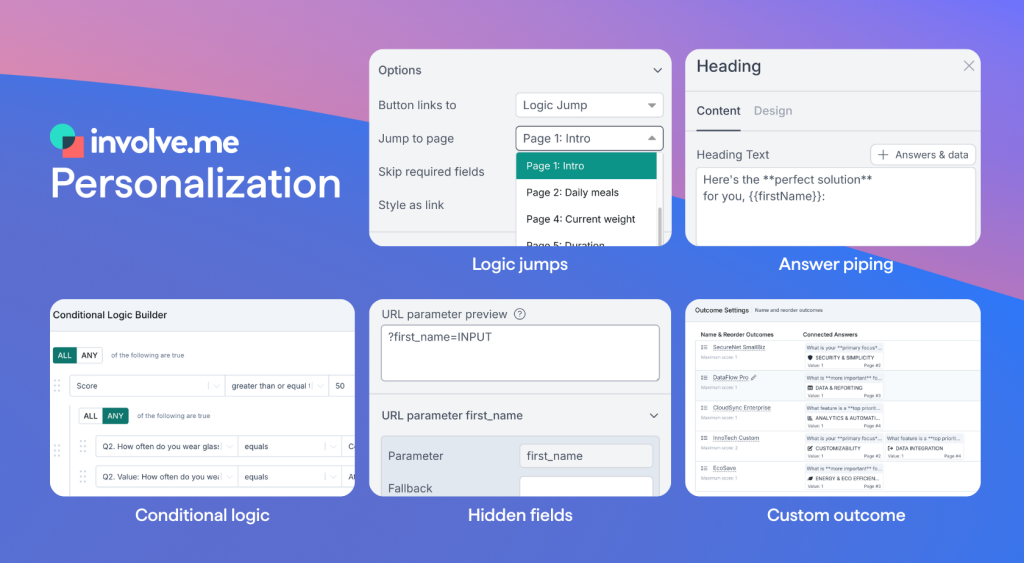
For more information on the anatomy of a high-converting landing page, read our article on landing page structure.
How To Optimize Your Landing Page: Step-By-Step
Here’s a step-by-step game plan for good landing page optimization. Whether you’re starting from scratch or improving an existing page, these steps cover the bases from planning to continuous improvement:
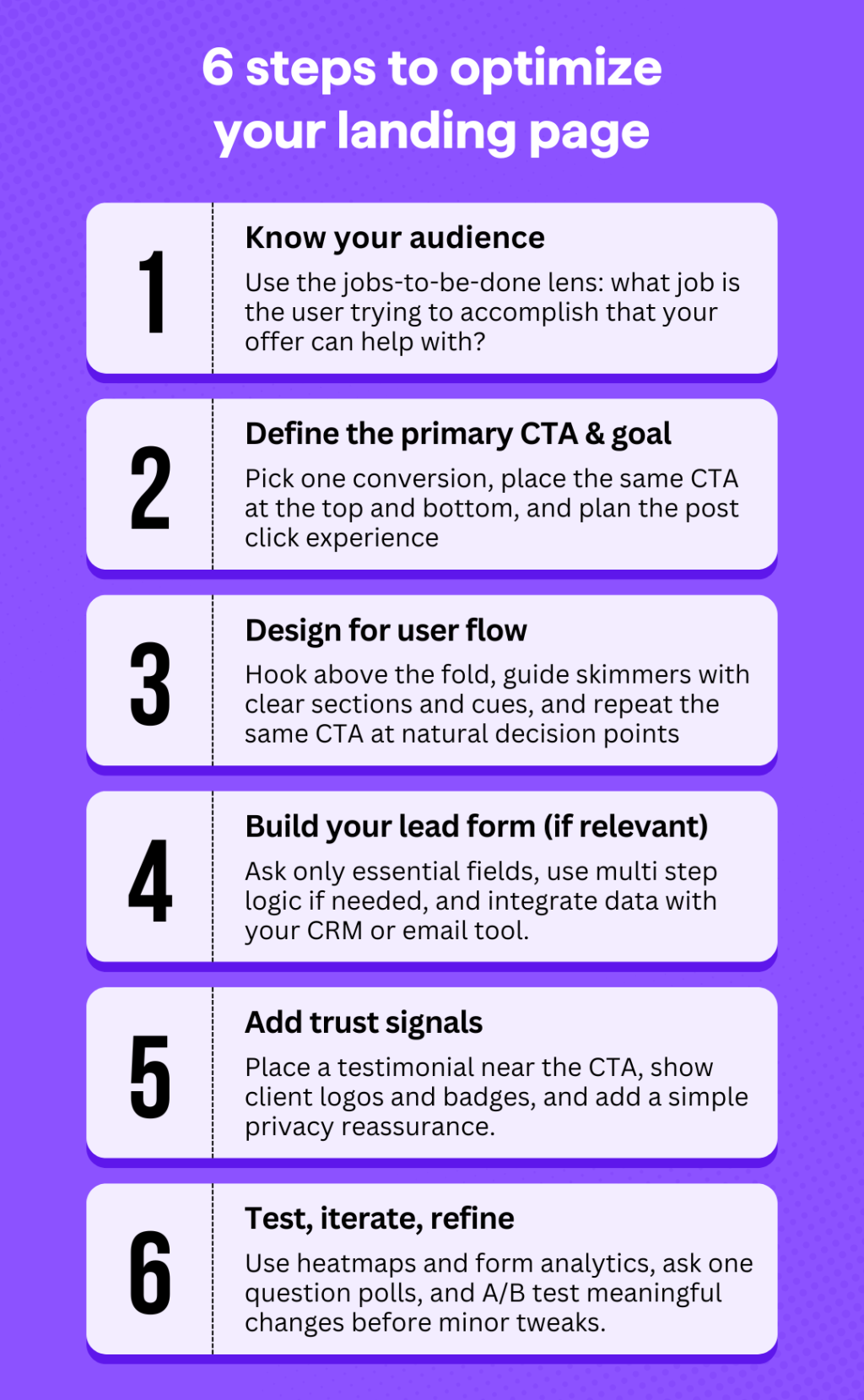
Step 1: Know Your Audience
Great landing pages start with people. Who’s showing up? What do they need right now? Use the jobs-to-be-done lens: what job is the target audience trying to accomplish that your offer can help with?
Budget help? Lead with “save money” and “track expenses easily.”
Learning a skill? Promise specific outcomes from your webinar or guide.
Do the research first. Not later. Use surveys and forms on the page or before it.
Already have customers? Ask what value they got and what convinced them to act.
Pre-launch? Run a simple questionnaire on your site or social profiles to surface pain points.
Tools like involve.me make this easy with conversational forms and quizzes that both qualify visitors and collect feedback.
Then mirror what you hear. Use their words in your copy.
If people keep saying, “I don’t have time to learn design,” your headline writes itself: “Design your website in 5 minutes (no experience needed).”
Short. Clear. On target.
The result? Relevance. Because your headline, subheads, and CTAs speak directly to the job they’re trying to get done.
Here is a practical workflow you can use. Ask 3 to 5 questions and map answers to copy:
Question | Identify | Use in copy of: |
What brought you here today? | Top pain | Headline |
What are you trying to accomplish? | Desired outcome | Subhead |
What almost made you leave? | Objection | Proof or FAQ |
Step 2: Define the Primary CTA and Conversion Goal
This one might sound obvious, but it’s crucial to pick one single goal. For example: Email signup, or product purchase, or event registration…
Everything on the page should push that one thing. Pages go off track when you add extras.
Here is an example to avoid. Let’s say you want signups. But then, you also mention following on social media, or checking out the blog. Now the visitor has options. Options dilute clicks. Your main conversion rate drops.
Think of a landing page like a one-lane road. No exits. No scenic detours. Just the destination.
Choose your primary call to action and make it the star.
If it’s a form, the form should be hard to miss. If it’s a button to another step, place it where it feels natural to act.
Smart pattern:
One CTA near the top for people ready now
The same CTA near the bottom for people who need more info first
Both should fire the same conversion event.
Don’t stop there, plan the post-click.
If it’s a signup, optimize the thank-you page and the follow-up email.
If it’s a purchase, make checkout smooth and fast. No surprises. No friction.
Be crystal clear. Visitors should never wonder what to do next. Use action-oriented copy:
“Get my free quote” beats “Submit.”
“Start free trial” beats “Learn more.”
Avoid multiple competing CTAs. If you must include a safety-net action (maybe “Contact us”), make it quiet. Smaller. Visually distant from the main call to action.
I’ve seen this play out many times. I once reviewed a page that wanted signups but also asked for social follows and promoted three blog posts. People wandered. After we cut the extras and doubled down on one call to action, the path felt obvious. The page finally did its job.
Final filter: look at every section and ask, “Does this help the user move toward clicking the CTA?” If yes, keep it. If not, cut it or rewrite it.
Step 3: Design for User Flow (above the Fold, Attention Cues)
You’re not arranging blocks. You’re telling a story. The goal is simple: move visitors from curious to convinced to clicking.
Here’s the typical flow:
Visitor arrives with a question → they see an immediate answer or value prop → they scroll and find proof that builds interest and trust → a well-timed CTA appears.
Clean & effective.
Above the fold, it’s key to hook fast. This top section should earn the next scroll.
Headline: your value prop in one clear sentence.
Subheadline or short paragraph: a quick expansion of the promise.
Primary CTA: button or form, visible right away.
Hero visual: product, context, or emotion. Keep it relevant.
Height: don’t make this section so tall that key info slips below the fold.
Landing page optimization example for a webinar page:
Headline: “Learn SEO in 5 Days (Free Course)”
Subtext: “Join our free 5-day course to master SEO basics and rank higher.”
Form: email field + “Reserve My Spot” button
All visible without scrolling. No hunting, no guessing.
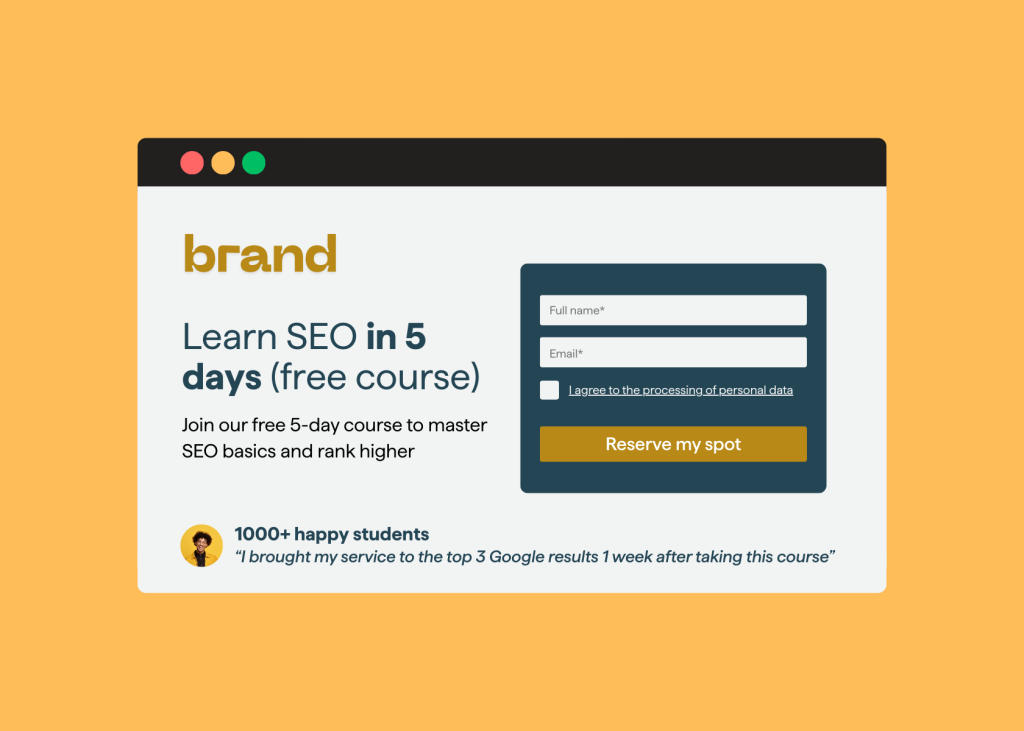
Use attention cues to guide the eye. People skim. Help them land on what matters.
Subtle arrow or “scroll” indicator to nudge movement.
Lines or shapes that lead from copy to the form.
Photos of people looking toward the CTA.
Section headings that tell the story on their own: Problem → Solution → Benefits → Testimonial → CTA.
Then, make sure to lay out the page in the order a skeptic would find persuasive.
State the offer/value in the headline.
Explain what they get and how it works. Short bullets beat walls of text.
Add credibility: testimonials, client logos, trust badges.
Handle objections: “No credit card required,” “Only 100 spots,” or a tight FAQ.
Repeat the CTA. Different context, same action.
This structure is not rigid, but the idea is to anticipate the user’s questions and answer them in sequence.
Page length matters. If it’s a longer page, break it into sections with clear headers and maybe alternating background colors to keep your landing page design visually engaging. Keep sections tight and skimmable.
Also, don’t forget visuals, but keep it light. Relevant beats decorative.
Product shots or happy customers using it.
Short videos or a quick 30-second demo GIF.
Optimize file sizes. Use lazy loading where you can.
The goal: add clarity without slowing the page.
Finally, gut checks before you ship
If you scroll quickly, do the key points still land?
After reading, does the call to action feel like the obvious next step?
Step 4: Build Your Lead Form (if Relevant)
If your landing page is built to capture leads, then you will need a form to do the heavy lifting. Which means optimizing that form is kind of a big deal.
The rule of thumb when building a form? Ask for what you actually need. Every extra form field is just another chance for someone to say, “Nah, not worth it.”
So keep it short. Keep it relevant. And make the whole experience feel effortless.
You can always get more valuable information after the conversion (during onboarding, follow-up emails, or later down the funnel). Don’t make your form an obstacle. Make it part of the landing page experience.
Now what if you really need to ask more than 5-6 questions? Make it multi-step.
Ever seen a form with 10+ fields crammed into one page? Yeah, most users bounce.
Now imagine this instead:
Step 1: "What's your name and email?"
Step 2: "A few quick questions…"
Step 3: "Tell us a bit more."
Breaking things up like this makes the process feel lighter.
And it works. Multi-step forms can increase conversion rates by up to 300% compared to those long, single-page forms.
involve.me makes setting this up painless. Add conditional logic, progress bars, branching questions,... whatever you need to guide users through.
And as I said above, make sure to personalize that mult-step flow.
Let’s say you're offering a free consultation. Instead of a bland "Name, Email, Message" form, build an interactive landing page experience.
Someone clicks “Get a Free Consultation.” Boom, they're dropped into a quick quiz:
"What’s your main financial goal?"
"What’s your current monthly budget?"
At the end, they pop in their email to get personalized results.
What just happened? You qualified a lead and kept them engaged the entire time.
Even if you're just looking for a basic form, involve.me still brings the goods:
Conditional logic: Show or hide fields based on answers, so users only see what’s relevant.
Templates that convert: Customize fonts, colors, and layouts to closely match your brand—no coding needed.
Integrations: Send data straight to your CRM, email platform, or Google Sheets. Follow-ups can be automated from the moment someone hits “submit.”
Built-in analytics: See where users drop off. Spot the friction. Fix it. That’s how you improve completion rates.
Step 5: Add Trust Signals: Testimonials, Badges, Social Proof
People don’t trust easily online. Can’t blame them, there’s a ton of noise out there.
That’s where trust signals like social proof come in. They give visitors the nudge they need by showing that others already trust you, and that it’s safe to do the same.
Pretty much every good landing page uses them. Here's what to consider adding:
Testimonials
These are your digital word-of-mouth. A quick quote from a happy customer, ideally with a name, photo, and maybe a company name, works wonders for social proof.
Want them to really land? Drop one near your CTA. Especially where someone might pause and think, "Hmm… is this legit? Will it work for me?"
Even just one solid quote like: "This tool helped us boost conversions by 50%! — Jane D." That’s enough to push a user over the edge.
Client Logos
Got big-name clients? Or just a lot of users? Show them off.
A strip of logos like "Trusted by ACME, XYZ Inc., and 500+ businesses" gives instant credibility. It's a shortcut to saying, "See? You're not the first one here."
(Just make sure you have permission before you slap any logos on your site.)
Trust Badges & Certifications
Think:
Security badges (SSL icons, "Verified by Norton")
Payment icons (Visa, MasterCard, PayPal)
Industry creds ("#1 on G2," "HIPAA Compliant")
These tiny symbols do a lot of heavy lifting when it comes to building confidence.
Social Proof Numbers
Numbers add weight. Consider phrases like:
"Join 10,000+ subscribers"
"Over 5,000 downloads and counting"
People trust what others are already doing. It’s the bandwagon effect.
Mini Case Studies or Quotes
If you’ve got the space (and the story), include a quick success snippet: "How John used [your tool] to double his leads in 30 days"
Even a short text quote or a video testimonial can do the trick.
Quick design tip: Make these elements pop, but don’t let them take over. A great layout idea:
Highlight a testimonial mid-page in italics or a different font
Use grayscale logos in a neat row
It’s all about subtle social proof reinforcement, not shouting for attention.
At the end of the day, trust signals are about calming nerves.
"Is this a scam?"
"Will this work for me?"
"Is my payment safe?"
Answer those upfront, and you’ll lower resistance. Even adding a tiny lock icon with a line like "We respect your privacy. No spam ever." near your signup form can make a huge difference.
Step 6: Test, Iterate, and Refine with Behavioral Data
So, you’ve built your landing page. You followed the right steps. It looks good. It works.
But you're not done.
Landing page optimization is a continuous process. You need to launch, measure, learn... then adjust.
Over time, that 5% conversion page? It could become a 15% conversion machine.
Here’s how to do that with real user data:
Start With Behavioral Data
Use tools like Hotjar or Crazy Egg to track how people interact with your page.
Scroll maps show how far users scroll. If they’re bouncing before they hit your CTA, that’s a problem.
Click maps reveal where they’re clicking. Maybe they’re tapping something that’s not even clickable. That’s friction.
Session recordings let you watch real users in action. You’ll spot stuff you’d never guess otherwise, like hesitation, rage clicks, or drop-off zones.
Dive Into Form Analytics
Using involve.me or similar tools, check your form’s performance.
Are users starting the form but dropping off halfway?
Is there a specific field that’s killing conversions?
Simple example: Let’s say people quit at the “Phone number” field. That’s a clue. Try removing it or making it optional.
Ask Users Directly
Set up quick polls or exit-intent surveys. Something simple like:
“What’s stopping you from signing up today?”
Perhaps users will say “I’m confused about the pricing”, which tells you to address pricing or offer more clarity on the page.
Form Hypotheses and Test
Take your valuable insights and turn them into testable ideas:
“If I clarify the benefit in the headline, maybe more people will scroll.”
“If I move the testimonial higher, maybe it’ll build trust faster.”
Make one change at a time. Then track the results.
If you’ve got traffic (a few hundred visitors/week is a good start), run A/B tests:
Version A: Original headline
Version B: New headline
See which one is converting visitors better. Simple as that.
Pro tip: Focus on big, meaningful changes first. Headlines, layout, offers. Don’t waste time testing button color unless you’ve got serious traffic.
Not enough traffic for A/B testing? Try sequential testing. Change one thing, monitor results, then move to the next. Just be careful, other factors like seasonality or source of traffic can impact your results.
Dive deeper into landing page optimization with our list of 11 landing page optimization best practices.
What Tools Help With Landing Page Optimization?
Landing page optimization is easier and more effective when you have the right tools in your toolkit. Different tools serve different purposes: building pages, analyzing user behavior, running experiments, and automating online marketing actions.
Here are some categories of tools (and specific examples) that can help you improve your landing page performance:
Involve.me – Interactive Landing Page and Form Builder
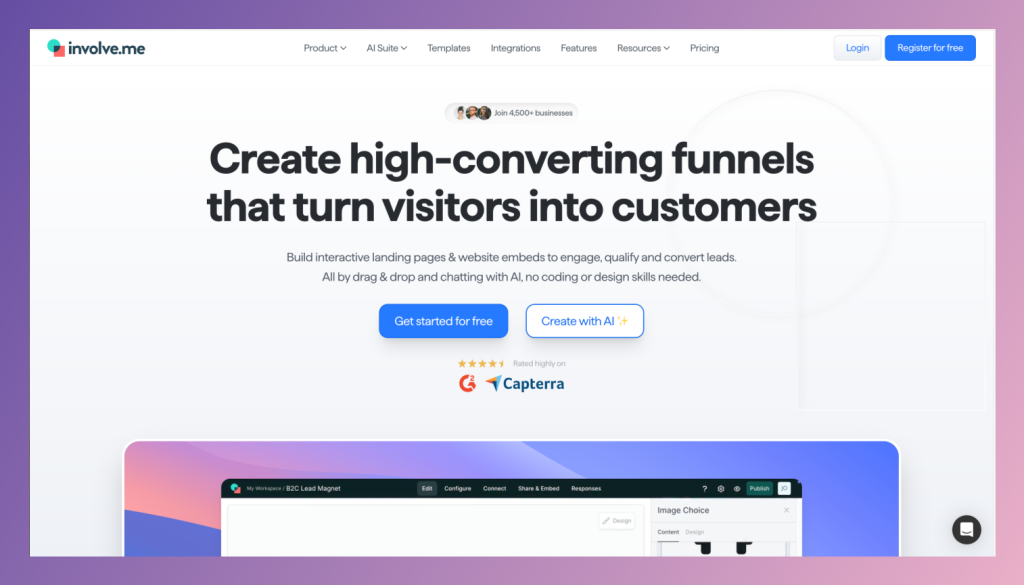
Need a perfect landing page fast, but don’t want to mess with code? involve.me has you covered. It’s a no-code platform for building high-converting multi-step flows.
What makes it stand out is interactivity and personalization. Instead of a static page, you can add calculators, surveys, or conditional workflows that make the landing page experience feel personal, and that usually means higher conversions.
Key Features:
Drag & drop + AI agent: Build and edit pages by adding text, images, videos, forms, and buttons. No coding required.
Conditional logic: Show content based on user input for instant personalization.
Personalized outcomes: Create multi-step flows with custom outcomes based on answers
Templates: 300+ pre-designed funnels and pages you can tweak to fit your brand.
Integrations: Connect with 60+ tools like Mailchimp, HubSpot, Salesforce, or Zapier. Leads flow straight into your CRM or email list.
Analytics: Track views, completions, conversion rates, and drop-offs to improve results.A/B Testing: Rapidly compare two variations of your landing page
Flexible publishing: Use as a standalone landing page or embed into your website.
Payments: Users can securely pay for your product/service directly from the page
involve.me’s funnel builder aspect covers what traditional landing page builders might miss: advanced forms, quizzes, automated emails, and payment collection. That means you don’t need a separate form tool or payment widget, it’s all in one, which simplifies your stack.
In short: involve.me helps you create engaging, conversion-focused landing pages fast, while keeping everything in one place. Generating a landing page with the AI Agent is a matter of minutes. No code needed.
Give it a try, it's free!
Hotjar – Behavior Analytics (heat Maps, Session Replays)
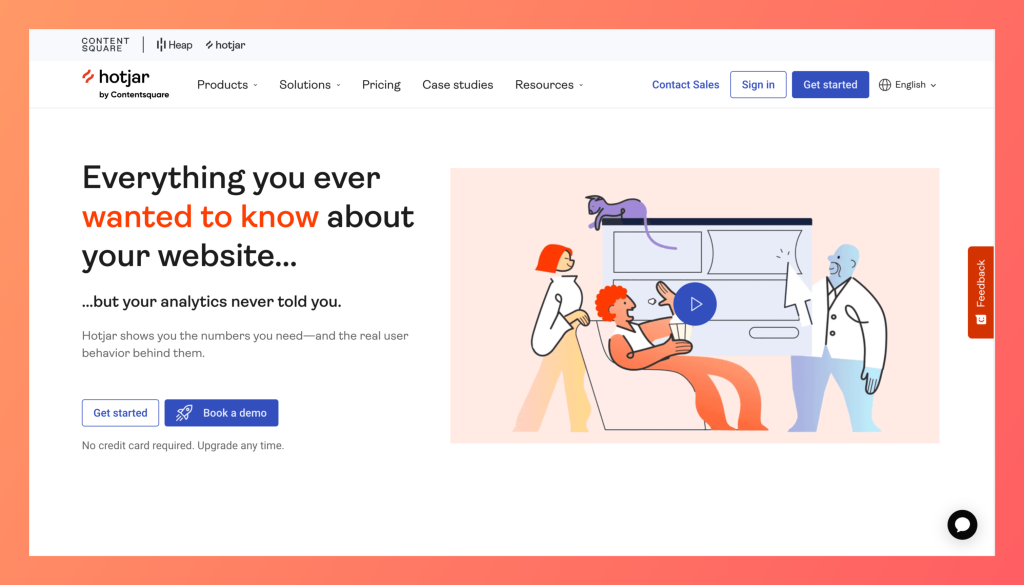
Want to know what visitors are actually doing on your landing page? That’s what Hotjar is for. It’s a behavior analytics tool that shows you how people interact with your site.
Key Features:
Heatmaps: See user behavior: where they click, tap, scroll, and move their cursor. Maybe lots of people click an image expecting it to be a button. Or only 30% scroll far enough to see your sign-up form. Heatmaps tell you what grabs attention and what gets ignored.
Session recordings: Watch anonymized videos of real user sessions. You might notice people scrolling back and forth, stuck on a form field, or unable to find what they need. You can even filter recordings (for example, only sessions where users bounced quickly).
Feedback polls & surveys: Add small widgets like “How was your experience?” or exit surveys asking “What stopped you from signing up today?” These open-text answers add context to the numbers. (You can also use involve.me for this)
Hotjar shows you where people pay attention and where they struggle. Maybe your scroll heat map reveals no one reaches the FAQ at the bottom. Or recordings show users clicking your navigation menu and leaving. Both signal it’s time to tweak the layout.
The value? Instead of just knowing your conversion rate is 5%, you find out why the other 95% didn’t convert. That’s the kind of actionable insight that drives meaningful changes.
A/B Testing Platforms
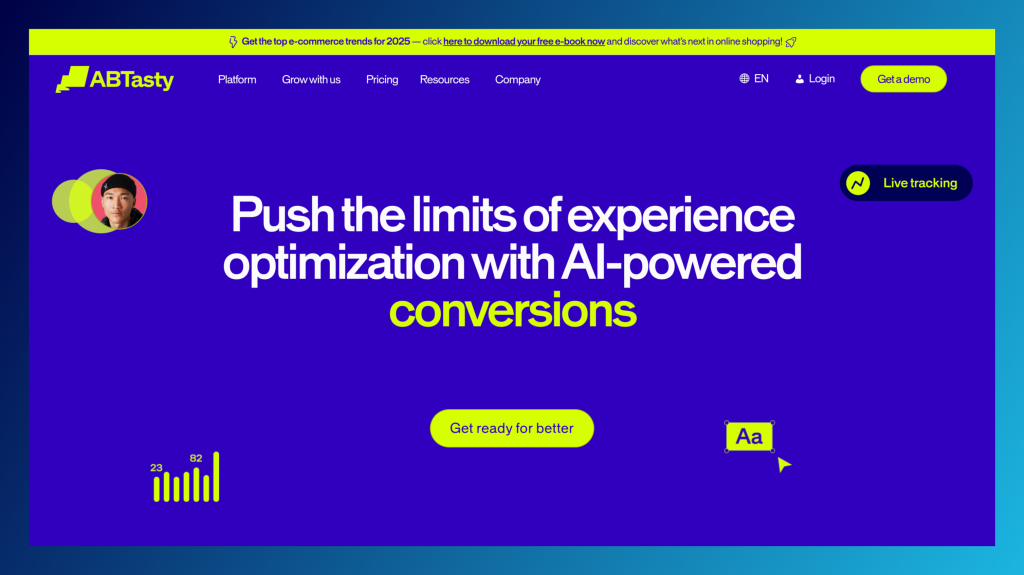
When it comes to good landing page optimization, guessing isn’t enough. You need data. That’s where A/B testing tools come in. They let you pit two (or more) versions of a page against each other and see which one actually converts better.
Regardless of the specific tool, the purpose is:
Create experiments easily: These tools typically have a visual editor to modify your page (e.g., change headline text, hide an element, swap an image) for the variant, without coding. Or you can use them to split traffic between two URLs.
Split traffic and gather stats: They randomly divide your visitors into control and variant groups and track conversions (you usually integrate with an analytics or add a snippet to count a conversion event). At the end of the test (or as it runs), you get data on which version had a higher conversion rate and whether it’s statistically significant.
Personalization and targeting: Some tools, like A/B Tasty, also double as personalization platforms, where you can show different content to different segments (like first-time vs returning visitors) outside of strict A/B tests.
For landing page optimization, A/B testing is how you iteratively improve. For example, you might test:
Headline A vs Headline B (which yields more sign-ups).
Long-form page vs Short-form page.
With testimonials vs Without (though usually one would assume “with” is better, it’s good to test placement or specifics).
Imagery variations, or different form types (multi-step form vs single-step).
Running these experiments helps you quantify the uplift from changes. It takes the guesswork and HIPPO (highest-paid person’s opinion) out of the equation and lets the users vote with their actions.
It’s worth noting that some landing page builders (like involve.me) have built-in A/B testing capabilities. If you need additional functionality, consider dedicated A/B testing platforms such as A/B Tasty or Kameleoon.
Google Analytics 4 – Traffic + Conversion Funnel Analysis

GA4 tracks user behavior and traffic across your site or app. For landing pages, it helps you:
1) Monitor Performance
Visitors, traffic sources (eg. organic traffic, paid traffic...), engagement/bounce.
Create a conversion event (e.g., form submit) to see conversion rate.
2) Set Up Conversion Funnels
You can configure a funnel in GA4 to visualize the steps (Eg. Landing Page view -> Form Start -> Form Complete)
This shows if there’s a big drop-off at a particular step. (Eg. 1,000 views, 300 form starts, 50 completes? The form likely needs work).
3) Analyze by Segments
GA4 allows you to break down performance by different dimensions, such as device, geo, campaign, source.
For example: Desktop at 8% vs. mobile at 3%? Fix mobile UX. Some regions convert better? Try localized tweaks.
5) Use the Landing Page Report
GA4 has a specific section for landing pages where you can see key performance indicators (KPIs) per page, including conversion events attributed to those page views. It’s a bread-and-butter tool – not glamorous, but essential for landing page optimization. It answers the “what is happening” quantitatively.
Example: one UTM source converts worse than another. Maybe the traffic from organic search is less qualified, or you should tailor a variant landing page for that target audience.
6) Track Micro-conversions
With GA4’s event model, you can track micro-conversions in addition to your main conversion, such as button clicks, or how many scroll 75% down. Want to know who sees pricing? Fire an event there.
Pro tip: involve.me projects can be linked with GA, so you can track involve.me page events in GA too if needed. Also, GA + Hotjar make a great combo: GA tells you what is happening in aggregate, Hotjar helps explain why by looking at individual behavior. The Hotjar-GA integration can even let you filter Hotjar data based on GA events bridging quantitative and qualitative.
HubSpot / Zapier – Integrations for Automation
After a visitor converts on your landing page, what next? That’s where online marketing automation tools come in. You want to follow up fast, drop contacts into nurture, and push data into your CRM.
HubSpot handles automated emails and lead management. Zapier connects your page to thousands of apps when there’s no native integration. Think Sheets rows, Slack pings, CRM updates.
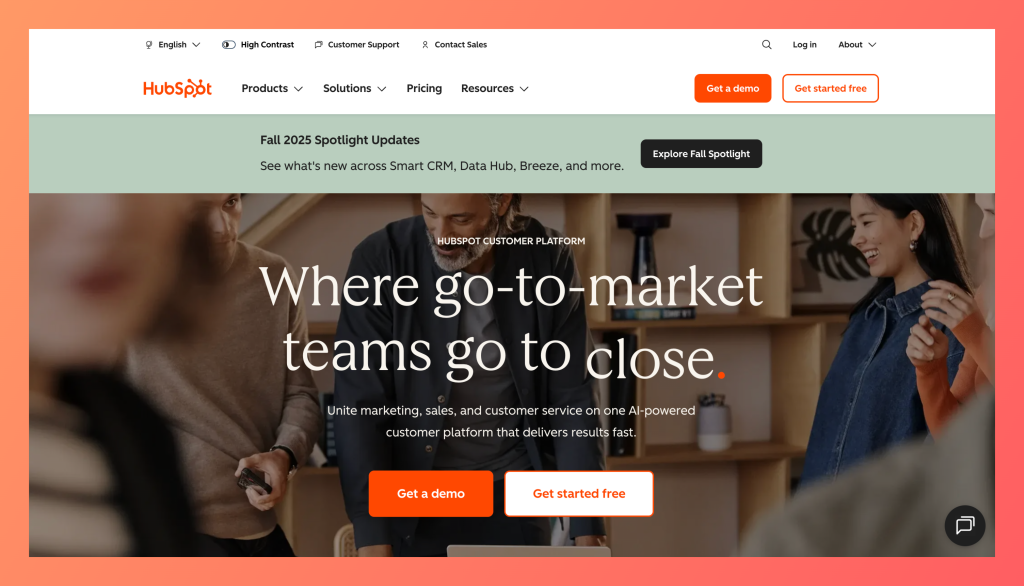
For example, if someone signs up on your landing page for a free trial, you might want to automatically:
Send them a personalized welcome email (via HubSpot or Mailchimp) within seconds, while they’re still warm. This improves the chance they actually take the next step (download the trial, etc.), essentially optimizing the conversion funnel beyond the landing page.
Notify your sales team or add the lead to a CRM (HubSpot, Salesforce) so that a salesperson can follow up if it’s a high-touch product. Speed to lead is crucial, contacting a lead within an hour increases conversion substantially compared to waiting a day.
Zapier acts as the glue if a direct integration isn’t available. Suppose you want to update a Google Sheet and post a message on a Discord channel every time someone registers via your landing page, you could set up a Zap. This level of automation ensures no lead slips through cracks and you can respond or react in real time.

While automation tools might not tweak the landing page itself, they are essential for a holistic optimization strategy. They turn conversions into satisfied users or paying customers by handling immediate follow-up. And a seamless back-end process means you can scale your online marketing campaigns by focusing on tweaking the page itself while the tools handle the admin of each conversion. It’s the “last mile” of conversion optimization.
(On involve.me: the platform offers many integrations out-of-the-box, including HubSpot and Zapier, so you can connect your landing page in a few clicks. No need to manually export CSVs of leads).
Common Landing Page Mistakes To Avoid
Even experienced marketers can mess up a landing page.
The layout might look fine on your screen. The messaging might sound sharp in your head. But if it confuses visitors or slows them down, your conversions will tank.
Here are some of the biggest landing page mistakes that quietly kill results—and how to fix them fast.
1) A Cluttered Layout with No Clear Flow
Ever land on a page and feel like you’ve been thrown into a blender?
Too much text. Too many images. Zero breathing room. And no clear path for your eyes to follow.
That’s what happens when visual hierarchy is missing. Your value prop gets buried. And your visitors? They bounce.
What to fix:
Cut the fluff. Ask yourself: Does this need to be here to drive a conversion? If not, kill it or move it to a thank-you page.
Use whitespace. Don’t cram. Let the design breathe.
Stick to one message. If you’ve got three CTAs competing on the same screen, you don’t have a landing page, you have a menu.
Keep fonts and colors simple. Too many styles = chaos. Stick to a palette and type hierarchy that guides.
Check mobile. What looks tidy on desktop might be a vertical mess on a phone.
The cleaner your layout, the easier it is for visitors to trust you and take action.
2) Vague or Conflicting CTAs
A button that says “Submit”? Not helpful.
A page with five CTAs pointing in different directions? Even worse.
When people don’t know what action to take, or why they should take it, they usually do nothing.
What to fix:
Pick one primary CTA. Make it obvious. Make it bold. Make it clear what happens next.
Be specific. “Download the Free Guide” beats “Learn More.”
Don’t bury the CTA. Put it above the fold and sprinkle it a few more times down the page.
Make it pop. Use a contrasting color. Make it look clickable.
Avoid CTA clutter. One action. One focus. That’s how you get clicks.
Want more clicks? Say exactly what the user will get when they click. No surprises. No fluff.
3) Asking for Too Much Info Too Soon
Here’s the deal: people don’t want to give you their life story just to get a free download.
Long forms scare people off. Especially if you’re asking for stuff you don’t really need (looking at you, “Phone Number” field).
What to fix:
Only ask for the essentials. Usually, that’s just name + email.
Explain why you need the info. A little context can ease anxiety.
Use multi-step forms. Long form? Break it up: ask easy stuff first, then personal details.
Think mobile. Use the right input types so the right keyboard shows up.
Respect privacy. Don’t ask for what you don’t need.
Simple rule: the less you ask, the more you get. Get the lead first. You can qualify them later.
4) Ignoring Mobile Optimization
If your page looks great on desktop but breaks on mobile, you’re throwing away half your traffic.
Slow loads. Tiny text. Scroll bars. Buttons too small to tap. It all adds up to a bounce.
What to fix:
Design for mobile first. Then scale up to desktop.
Use responsive design. No excuses.
Test everything. Use tools like PageSpeed Insights.
Think mobile behavior. Shorter sections, faster load times, tappable buttons.
Cut heavy media. Big images and auto-play videos don’t belong on mobile.
Delight mobile users and you’ll outshine competitors who treat mobile like an afterthought.
5) Inconsistent Messaging from Ad to Page
Your Google ad promised “50% off.”
Your landing page says “Welcome to Our Store.”
See the problem?
If visitors don’t see the message they clicked for, they’ll question everything, including your credibility.
What to fix:
Mirror your ad copy. Use the same phrases and tone.
Highlight the same offer. Make it the first thing they see.
Segment your landing pages. Different traffic sources = different pages - if it makes sense.
Keep tone and visuals aligned. If your ad is playful, don’t hit visitors with corporate-speak.
Your goal is simple: Make the page feel like a seamless continuation of the click.
Let's Wrap-up
Perfect landing pages do a few things exceptionally well: clear promise, one action, fast mobile UX, clean design, and just enough personalization to feel relevant. Then they get better through testing.
When it comes to implementing landing page optimization, treat your landing page as a living asset. Keep iterating. Keep measuring. Keep aligning your message to the click that brought the visitor in.
Do that, and you won’t just get more conversions. You’ll get better ones. Consistently.
Build a high-converting landing page
FAQs about landing page optimization
-
Think of your homepage as the hotel lobby. It’s welcoming, has lots of doors, and serves everyone. Multiple paths. Many goals. A landing page is the private meeting room. One purpose. One next step. Minimal navigation. You typically send ad or email traffic to a landing page so the message matches the click and the call to action is obvious. The result? Fewer distractions. More conversions. For campaign traffic, a focused landing page almost always beats sending people to a homepage.
-
Yes. Absolutely. involve.me is built for non-technical folks. Drag. Drop. Type. Publish. No code. Start with a template, a blank canvas or by prompting our AI agent. Add text blocks, images, buttons, and form fields. Customize colors, fonts, and branding. The editor handles mobile layouts and functionality like conditional logic, form submissions, and integrations behind the scenes. Many users are marketers and founders who spin up professional pages quickly. You can publish on an involve.me domain or embed on your site.
-
Only as long as it needs to be to persuade someone to act. No magic word count.
For a simple offer or motivated visitors, a short page can win: Hero, a few bullets, clear CTA. For complex, high-stakes, or trust-heavy offer? Go longer. Add proof, details, FAQs, and objections handled. The rule: clarity and sufficiency. Include what your audience needs to feel confident, and trim the rest. Put essentials up top. People who need more will scroll. People who are ready will click. A practical starting point is a medium-length page with a handful of tight sections, then test from there. The lesson? Context matters. -
Start by deciding what “conversion” means, then measure it consistently. In Google Analytics 4, add your tag, define an event such as form_submit or button_click, and mark it as a conversion. GA4 will report visits, conversions, rates, and performance by source. If you’re building with involve.me, use its built-in analytics for views, submissions, conversion rate, and downloadable leads. Those step-by-step funnel stats pair nicely with GA’s aggregate view. Connect a CRM like HubSpot so leads flow into your pipeline and you can see what happens after sign-up. Add the Meta Pixel and Google Ads conversion tag so ad platforms can optimize. Tag campaign links with UTM parameters, so you can compare channels cleanly.


